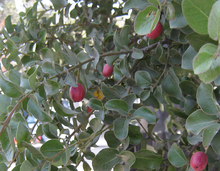Cryptocarya
| Cryptocarya | |
|---|---|

| |
| Cryptocarya alba | |
| Scientific classification | |
| Kingdom: | Plantae |
| Clade: | Tracheophytes |
| Clade: | Angiosperms |
| Clade: | Magnoliids |
| Order: | Laurales |
| Family: | Lauraceae |
| Genus: | Cryptocarya R.Br.[1] |
| Species | |
|
Over 360; SeeList ofCryptocaryaspecies | |
| Synonyms[1] | |
| |

Cryptocaryais a genus of about 360 species[1]of flowering plants in the laurel family,Lauraceae.Most species are trees, occasionally shrubs, distributed through theNeotropical,Afrotropical,Indomalayan,andAustralasian realms.Most plants in the genusCryptocaryahave leaves arranged alternately along the stems, small flowers with 6tepals,stamensin 2 rows, the inner row alternating withstaminodes,and the fruit is adrupe.
Description
[edit]Plants in the genusCryptocaryaare trees, occasionally shrubs, the leaves usually arranged alternately along the branches. The leaves arepetiolateandpinnately-veined.The flowers are arranged incymes,racemesorpaniclesin leaf axils usually at the ends of branches and often appearing as if on the ends of the branches. The flowers have both male and female parts, with 6 tepals usually erect as the flower opens, and 9 stamens in 2 rows, the inner row of 3 alternating with staminodes. Theovaryissessile,usually with an inconspicuousstigmaand the fruit is an elliptic to spherical, fleshy drupe, containing a single seed.[2][3][4]
Taxonomy
[edit]The genusCryptocaryawas first formally described in 1810 byRobert Brownin hisProdromus Florae Novae Hollandiae et Insulae Van Diemen.[1][5]The genus nameCryptocaryameans 'hidden nut', referring to the fruit that is hidden by the tepals.[6]
In a recent generic classification of Lauraceae based on DNA sequence,Cryptocaryawas found to be part of a strongly supported clade that also includesBeilschmiedia,Potameia,EndiandraandEndiandra.[7]
Species list
[edit]Distribution
[edit]Species ofCryptocaryaare found in some parts of South America, southern Africa, Madagascar, South Asia, Southeast Asia, Japan, New Guinea and Australia.[1]
Uses
[edit]The leaves ofC. woodiihave been found in prehistoric settlements in Africa and are believed to have been used for insect control.[8]
Essential oilis commercially harvested fromCryptocarya agathophylla(formerlyRavensara aromatica), a tree native to the lowland rainforests of eastern Madagascar. Known as ravensara oil, it is used foraromatherapyin Europe and America.[9]
References
[edit]- ^abcde"CryptocaryaR.Br ".Plants of the World Online.Royal Botanic Gardens, Kew.2023.Retrieved18 October2023.
- ^Le Cussan, J.; Hyland, Bernard P.M."Cryptocarya".Flora of Australia. Australian Biological Resources Study, Department of Climate Change, Energy, the Environment and Water: Canberra.Retrieved4 June2024.
- ^Harden, Gwen J."Cryptocarya".Royal Botanic Garden, Sydney.Retrieved4 June2024.
- ^"Cryptocarya".Northern Territory Government.Retrieved4 June2024.
- ^Brown, Robert (1810).Prodromus Florae Novae Hollandiae et Insulae Van Diemen.London. p. 402.Retrieved4 June2024.
- ^George, Alex; Sharr, Francis (2021).Western Australian Plant Names and Their Meanings(4th ed.). Kardinya, WA: Four Gables Press. p. 72.ISBN9780958034180.
- ^Van Der Werff, Henk (2006)."A Revision of the Malagasy endemic genusAspidostemonRohwer & Richter (Lauraceae "(PDF).Adansonia.28(1): 7–38. Archived fromthe original(PDF)on 2011-08-08.Retrieved2011-11-06.
- ^Wadley L, Sievers C, Bamford M, Goldberg P, Berna F, Miller C (2011). "Middle Stone Age bedding construction and settlement patterns at Sibudu, South Africa".Science.334(6061): 1388–91.Bibcode:2011Sci...334.1388W.doi:10.1126/science.1213317.PMID22158814.S2CID11063722.
- ^Hanitriniaina Sahondra Andrianoelisoa, Chantal Menut, Panja Ramanoelina, Falihery Raobelison, Philippe Collas de Chatelperron, & Pascal Danthu (2010). "Chemical Composition of Essential Oils From Bark and Leaves of Individual Trees of Ravensara aromatica Sonnerat",Journal of Essential Oil Research,22:1, 66-70, DOI: 10.1080/10412905.2010.9700267
External links
[edit]- Pictures ofCryptocarya albaor Peumoin Chile.
- "CryptocaryaR.Br ".Atlas of Living Australia.
